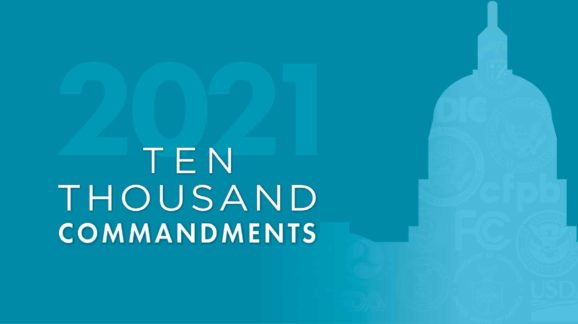The 2021 Edition of Ten Thousand Commandments Is Out Now

How much does regulation cost? It’s hard to tell, due to a lack of transparency. The government is legally required to tell the public how much it spends ($6.55 trillion in 2020), and how big the national debt is ($28 trillion as of June 2020). But regulatory agencies are reluctant to share their cost information—when they bother to calculate it at all. That’s why Wayne Crews puts together his Ten Thousand Commandments report every year. If agencies won’t make their basic information public, somebody should.
Wayne estimates, based on the incomplete information that agencies do disclose, that federal regulations cost about $1.9 trillion per year, or about $14,368 per household. That is more than households spend on food, clothing, health care, or any other expense except for housing (which is itself artificially expensive due to zoning and land-use regulations, steel and lumber tariffs, and financial regulations that make lending and mortgages more expensive).
Put another way, if the federal regulatory state were its own country, it would have the world’s eighth largest GDP, behind Italy and ahead of Brazil.
It is worth emphasizing that $1.9 trillion per year is just an approximation, based on the limited information agencies make available. Other studies give even higher estimates. It is also possible the real number is lower, but the fact that agencies have not offered credible estimates, even though these would make them look good, makes this unlikely.
This year’s Ten Thousand Commandments also contains a wrap-up of the Trump administration’s impact on regulatory costs. The picture is mixed.
On the plus side, Executive Order 13771 cleaned out hundreds of old rules from the books by requiring agencies to remove two old regulations for each new one it issued. Though this one-in, two-out policy had diminishing returns as the low-hanging fruit was mostly picked after the first two years, it was still a success. The order’s additional requirement that agencies impose zero net new regulatory costs served as a soft regulatory budget, putting a cap on the burdens that agencies could impose.
New regulations under Trump reached their lowest levels since recordkeeping began in the 1970s. In 2019, the number of new rules went below 3,000 for the first time ever—despite the fact that getting rid of old rules requires publishing new rules to formalize the changes. Federal Register page counts also went down sharply, though Trump’s final edition ended up as the second highest in the Register’s 85-year history, exceeded only by Barack Obama’s final year.
On the downside, Trump increased regulation in several policy areas. His administration doubled tariffs and added other trade restrictions affecting hundreds of trillions of dollars of goods, further restricted immigration, filed the two largest antitrust lawsuits since the 1990s, made frequent threats to regulate or punish media companies, and showed little concern for separation of powers and other checks on executive power.
From the perspective of institutional design, the administration made a strategic error that let most of his reforms be reversed when he left office. Most of Trump’s positive regulatory reforms came through executive orders, which can be repealed by the next president. Permanent reform requires congressional legislation. Although Trump’s party held a majority in both congressional chambers for his first two years, he did not work with them to codify regulatory reforms.
For example, while Rep. Bob Good (R-VA) introduced the Guidance Out Of Darkness (GOOD) Act to enact permanent guidance document reform similar to the ones in Trump’s Executive Order 13891, the administration’s priorities were elsewhere. President Biden was able to undo them, and most of Trump’s other regulatory reforms, on his first day in office.
Guidance documents exist to clarify definitions and ambiguities in regulations. Courts routinely defer to them in cases, meaning that guidance documents often have the force of law, despite rarely going through the proper rulemaking process. Guidance documents are part of the larger problem of “regulatory dark matter,” which describes the phenomenon of agencies issuing new regulations through guidance documents, notices, press releases, and even blog posts without proper transparency and accountability.
EO 13891 was one of the first attempts to rein in dark matter rulemaking. It required agencies to publish all of their guidance documents in a single, searchable online portal accessible to the public. Guidance documents not published in the portal would no longer have any effect. The GOOD Act would have made this policy permanent.
Other reforms met a similar fate, such as the REINS Act to require congressional votes on major new regulations, and the Pandemic Preparedness, Response, and Recovery Act), which would have created an independent commission to put together a package of rules for Congress to repeal that are harming the COVID response and economic recovery.
It is important that the next reform-minded president learns from Trump’s mistake and involves Congress in reform efforts. Executive orders are better than nothing, but they are not enough.
For more on how big the regulatory state has grown, and for ideas to reform it, read the 2021 edition of Ten Thousand Commandments.